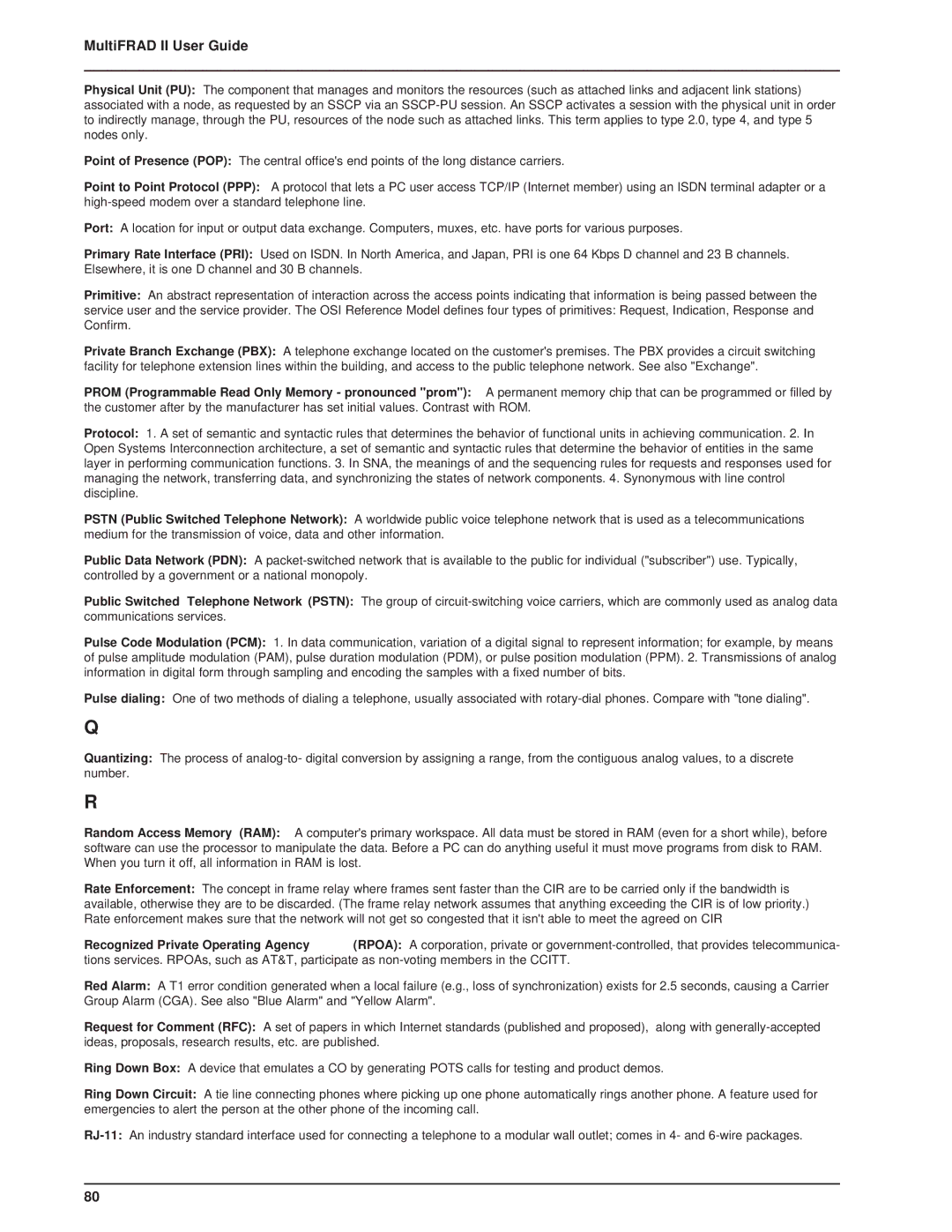
MultiFRAD II User Guide
Physical Unit (PU): The component that manages and monitors the resources (such as attached links and adjacent link stations) associated with a node, as requested by an SSCP via an
Point of Presence (POP): The central office's end points of the long distance carriers.
Point to Point Protocol (PPP): A protocol that lets a PC user access TCP/IP (Internet member) using an ISDN terminal adapter or a
Port: A location for input or output data exchange. Computers, muxes, etc. have ports for various purposes.
Primary Rate Interface (PRI): Used on ISDN. In North America, and Japan, PRI is one 64 Kbps D channel and 23 B channels. Elsewhere, it is one D channel and 30 B channels.
Primitive: An abstract representation of interaction across the access points indicating that information is being passed between the
service user and the service provider. The OSI Reference Model defines four types of primitives: Request, Indication, Response and Confirm.
Private Branch Exchange (PBX): A telephone exchange located on the customer's premises. The PBX provides a circuit switching facility for telephone extension lines within the building, and access to the public telephone network. See also "Exchange".
PROM (Programmable Read Only Memory - pronounced "prom"): A permanent memory chip that can be programmed or filled by the customer after by the manufacturer has set initial values. Contrast with ROM.
Protocol: 1. A set of semantic and syntactic rules that determines the behavior of functional units in achieving communication. 2. In Open Systems Interconnection architecture, a set of semantic and syntactic rules that determine the behavior of entities in the same layer in performing communication functions. 3. In SNA, the meanings of and the sequencing rules for requests and responses used for managing the network, transferring data, and synchronizing the states of network components. 4. Synonymous with line control discipline.
PSTN (Public Switched Telephone Network): A worldwide public voice telephone network that is used as a telecommunications medium for the transmission of voice, data and other information.
Public Data Network (PDN): A
Public Switched Telephone Network (PSTN): The group of
Pulse Code Modulation (PCM): 1. In data communication, variation of a digital signal to represent information; for example, by means of pulse amplitude modulation (PAM), pulse duration modulation (PDM), or pulse position modulation (PPM). 2. Transmissions of analog information in digital form through sampling and encoding the samples with a fixed number of bits.
Pulse dialing: One of two methods of dialing a telephone, usually associated with
Q
Quantizing: The process of
R
Random Access Memory (RAM): A computer's primary workspace. All data must be stored in RAM (even for a short while), before software can use the processor to manipulate the data. Before a PC can do anything useful it must move programs from disk to RAM. When you turn it off, all information in RAM is lost.
Rate Enforcement: The concept in frame relay where frames sent faster than the CIR are to be carried only if the bandwidth is available, otherwise they are to be discarded. (The frame relay network assumes that anything exceeding the CIR is of low priority.) Rate enforcement makes sure that the network will not get so congested that it isn't able to meet the agreed on CIR
Recognized Private Operating Agency (RPOA): A corporation, private or
tions services. RPOAs, such as AT&T, participate as
Red Alarm: A T1 error condition generated when a local failure (e.g., loss of synchronization) exists for 2.5 seconds, causing a Carrier Group Alarm (CGA). See also "Blue Alarm" and "Yellow Alarm".
Request for Comment (RFC): A set of papers in which Internet standards (published and proposed), along with
Ring Down Box: A device that emulates a CO by generating POTS calls for testing and product demos.
Ring Down Circuit: A tie line connecting phones where picking up one phone automatically rings another phone. A feature used for emergencies to alert the person at the other phone of the incoming call.
80
